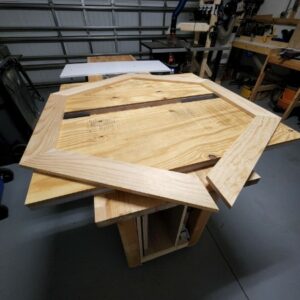Proper measurements for a hexagon gaming table
I am a hobbyist woodworker but have experience building furniture. Currently working on a hexagon-shaped gaming table. Not sure about the angles for each board that will form the outside frame. I cut 6 boards of equal length. I cut each end of the boards at 30 degrees. I used a stop block on my miter saw to ensure each board is the same. The end result is the gap in the hexagon (pictured). Should all 6 boards be the same length? Is 30 degrees the correct angle? The width of the blade shouldn’t matter as it cuts to the scrap side of the line. Appreciate any help.
















Replies
Stack your boards one on top of another matching long/short side - check for discrepancy.
Seem to be exact
Yes, 30 degrees is the correct angle for a typical hexagon, and equal length sides are required for a “regular” hexagon. I’m guessing that if all 6 sides are indeed the same length, your miter saw’s angle calibration is a bit off. Check it with a quality adjustable head tri-square or a 30-60-90 drafting triangle. Also remember that any miter cut changes angle as moisture content of the wood changes, so a stable environment is best.
Also, not all hexagons are regular with equal sides (check Wikipedia for some examples), so if your angles are good but the sides are slightly off in length, you may be able to close the gap by swapping sides around.
Interestingly, I recut the angles using 30 degrees on the right side of the blade and it worked. I have the Bosch 12" dual bevel glide miter saw but it's new and I have not done any fine-tuning. Maybe I should. Gonna cut a few more test cuts on pine boards before I make the actual cuts on my walnut boards. Thanks.
I have same saw and it is very finicky, and mine must be checked from time to time. I've noticed I can manipulate cut slightly by varying hand pressure on handle from side to side.
Honestly with anything that needs this level of precision i don't trust the number on the tool, I always verify and take a test cut to verify. Gauges on tools are not high precision.
If you want consistent results, a miter saw is not your tool of choice. I would use a table saw sled, with a 30º fence screwed to it. You can get that fence located very accurately because the ratio of the two non-hypotenuse sides of a 30º triangle is 1 to 2. So, for example, from your zero clearance cut edge, go over 12" along the fence. Then go up 6" along the cut edge. Draw a fine line, then another 2" or so up the sled to make room for the fence, and screw the fence right on the line. Cut one end of all the pieces, then screw a stop block to the sled. Make sure the stop block is big enough to catch the point at the end, not the sloping surface, as the force of the blade could shift the end away from the fence.
Another thing to note is that if any of the pieces are curved along their length, it makes accuracy much more difficult to obtain. You can get by if you cut the pieces just barely longer than needed before you make the first 30º cut, and have the concave side against the fence.
Oddly enough, given that we work with wood, you still may need a few touches with a sharp block plane to get everything perfectly closed. Good luck!
“[Deleted]”
I'm going to second jharveyb; the table saw sled is the way to go. And even though you already cut your boards, I'd redo the cuts on mdf test scraps until you get the layout dialed in.
Old thread revived by spam
This forum post is now archived. Commenting has been disabled